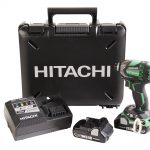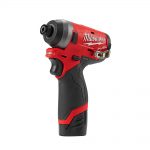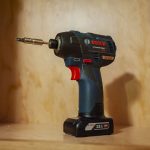Hydraulic Impact Driver – Should you have one?
Hydraulic Impact Driver – Should You Have One In Your Kit?
When you hear the term “Hydraulic Impact Driver “you either know exactly what I’m talking about or you wonder if it’s some weird industrial tool hooked up to hydraulic hoses like a giant concrete saw. Well, I can assure you that if you do any work indoors, you should take a closer look at this tool.
What Is a Hydraulic Impact Driver?
So what is a hydraulic impact and how is it different from a regular impact? First off, a regular impact has three main parts a hammer, anvil, and a spring. As the hammer portion turns, if there’s resistance on the anvil, the spring loads up until it releases and the hammer strikes the anvil in the direction of rotation delivering that impact force into the fastener. The hammer and anvil mechanism is all metal so it is pretty loud when activated in quick succession. Check out this video excerpt from ToolStop where a Bosch employee demonstrates the impact mechanism.
A Hydraulic Impact is different in that it uses oil to build up pressure, when the pressure is high enough, pawls get pushed out on the anvil mechanism so that the hammer grabs them as it rotates. Then the pressure decreases, and the pawls retract until the pressure builds again. This results in a much quieter operation.
Benefits of a Hydraulic Impact over a regular
The first and biggest benefit is that they are half as loud as a regular impact. The new Dewalt boasts a 57% decrease in sound over their regular impact when driving 3″ screws into a pressure treated 4×4. That is a significant number. I can guarantee that all of us tradespeople will have some hearing loss over our careers, using a quieter tool when possible only makes sense.
The second benefit is the hydraulic mechanism due to the way it’s constructed, has more sustained torque. A regular impact is like hitting the end of a wrench with a hammer, a hydraulic impact is like putting a cheater pipe over the wrench and giving it a bunch of half-second tugs. Both will tighten the fastener, but one has torque on the fastener for a longer duration.
Killer Applications for Hydraulic Drivers
The obvious applications are anything indoors. MEP Rough-ins, steel stud framing, accessories (mirrors, grab bars, soap, paper towel dispensers, etc), device-ing out, and even doors and hardware. It isn’t just new construction either. Remodeling of existing occupied spaces can always benefit from decreased sound and vibration.
I do a ton of healthcare remodeling, hospitals, clinics, etc. Places that have to stay open even during construction. They always appreciate reduced noise and vibration, especially considering many places have normal sound levels rivaling the local library.
The last killer application is casework (cabinetry). Any time your head is close to the fastener being driven, the quieter the tool, the better it is for you in the long run.

Limitations of Hydraulic Drivers
There are some applications where hydraulic drivers are not the best choice. Longer and larger diameter fasteners like concrete screw anchors (TitanHD) and timber screws are hard for hydraulic impacts (and regular impacts) but in these cases, I usually switch to an impact wrench anyway.
The other area that hydraulics suffer from is extreme cold. I’ve had two Milwaukee Surge hydraulic drivers over the 8 years they’ve been out. The first one only lasted like 3-4 months because I left it on the job in the double digits below zero and I think the oil was too viscous and leaked out when I started using it for the day. I’ve never got an official confirmation from the brands that cold is detrimental for these types of drivers but I’ve read other reports online of similar scenarios.
Who makes Hydraulic Impact Drivers?
Up until a few months ago, Makita and Milwaukee were the only brands that made hydraulics. The drawback to this was that there has been no updates to these tools in the 8 years since they’ve been out. Now Dewalt just released theirs and it boasts quieter operation, less vibration, and more power than the Makita and Milwaukee. I don’t know if this new release from Dewalt will trigger updates to the Makita and Milwaukee.
What I do know is that if you’re on Milwaukee M18 or M12, Makita 18V LXT, or Dewalt 20V a hydraulic impact driver should have a spot in your tool kit.
Where To Buy (ACME Tool)
Dewalt 20V Quiet Hydraulic Impact Bare Tool
About the author
Disclosure
Product reviews on this site contain our opinion of a product or service. We will always strive for objectivity and transparency in our reviews. Our goal is to provide readers with honest, objective information based on our own experiences. We never have and never will accept payment in exchange for a positive review. Many of the products that we review are provided to us for free by a manufacturer or retailer. In some cases, we also have advertising or affiliate relationships with manufacturers and retailers of products and services we review. For additional information please visit our additional disclosure policies.




























